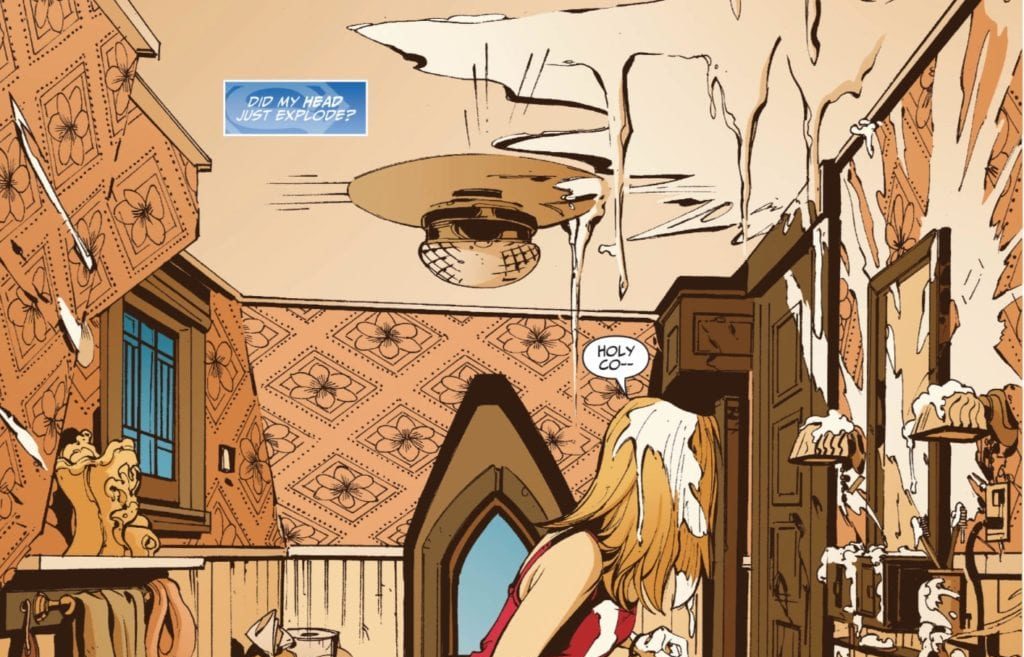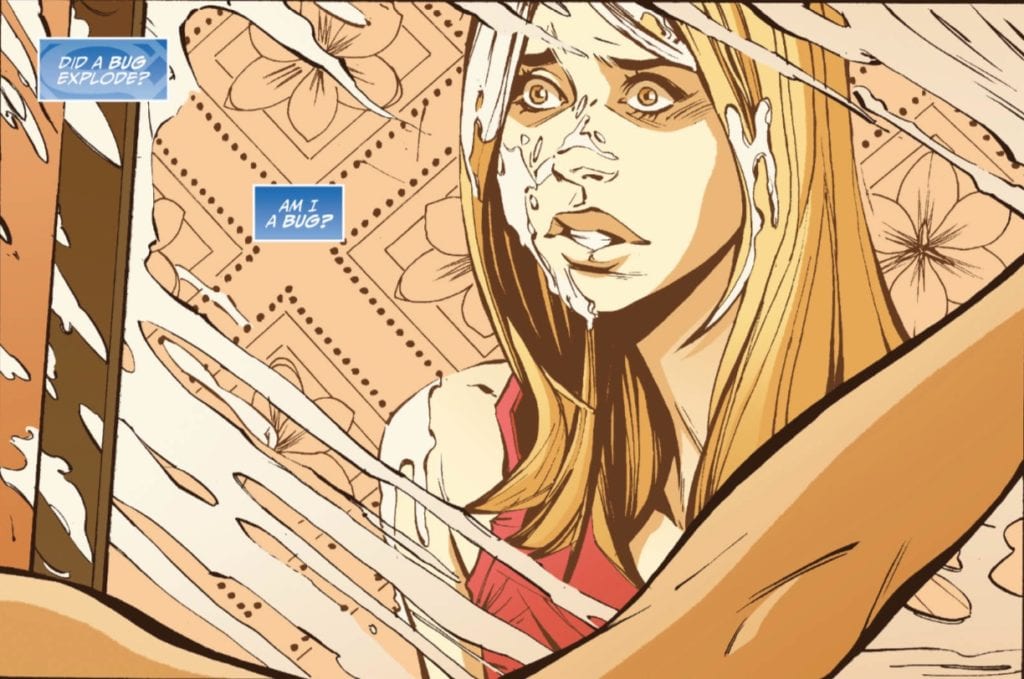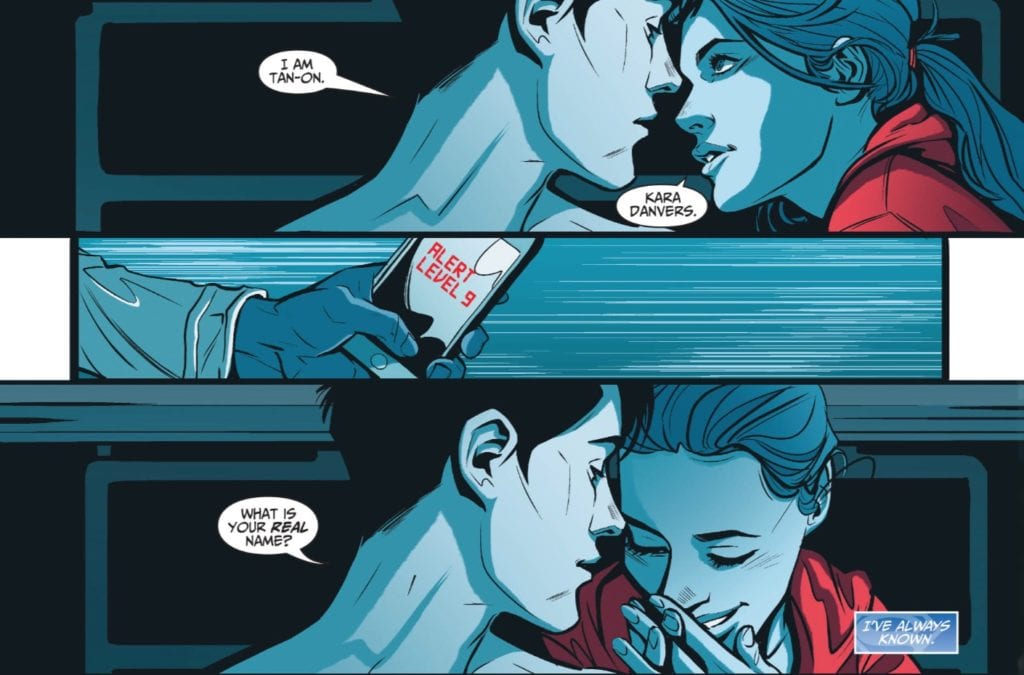On July 7, 2020, DC Comics releases an updated edition of Mariko Tamaki and Joëlle Jones’s limited series Supergirl – Being Super. With Sandu Florea assisting Jones, Jeremy Lawson on colors, and lettering by Saida Temofonte, this story reimagines the origins of Supergirl as she struggles to find her place to belong while trapped between two worlds.
Writing
Supergirl can be a hard character to get right and keep right. Sometimes, she’s a pale shadow of her well-known cousin. Other times, her alien nature is emphasized over-against any human connections or attachments to Earth. Still other times, she begins with an already convoluted status quo that degenerates into the worst kind of comic book silliness. One thing all of these stories have in common, however, is that eventually Supergirl comes face to face with Superman. Which she does. Eventually. The Man of Steel is quite de-centered in this story (at one point I wondered if he even existed in this tale), which allows Kara to shine!
Tamaki’s strategy is to copy part of Clark’s upbringing while making it unique to Kara. She was discovered in a spaceship by two farmers in the town of Midvale, Kansas, but these are not the Kents. Her father is a gruff but compassionate country man, slightly wary of his daughter’s powers, who may ask for her help around the farm, but Kara is her own person. She is an athlete (who carefully controls how fast she runs track). She is Gen-Z, constantly on her phone with her friends. And she is given her own unique inner world. While some of the elements of her life rhyme with Clark Kent’s, they are not the same, and Kara is given a chance to shine as a fully realized character.
Tamaki also explores Kara’s relationship with Krypton. She is still an older child when she is sent away in a spacecraft by her parents, but she blocks the memories from her mind, which allows her to embrace humanity more than, say, the New 52 version of Supergirl. With her powers fluctuating throughout the series, readers eventually learn that LexCorp is performing experiments on her and another Kryptonian, Tan-On (who I thought might be Clark at first, in some sort of role reversal), who having suffered at the hands of humanity seeks revenge against them. This puts Kara at odds with her homeworld the person who symbolizes her homeworld. After establishing that, yes, Superman does indeed exist in this world, Kara seeks advice from this other strange visitor from another planet. The Supergirl origin arc is complete, although in a way that builds on Kara as a unique character and gives her agency.
Art
One of the joys of this collected series is seeing teenage Kara navigate high school life as someone with superpowers. And these moments are illustrated beautifully by Jones and Florea. Now, some of you may have always wondered, “Do Kryptonians get acne?” and even more importantly, “If they get acne, is it ‘super acne’ since they’re on Earth?” Well, wonder no more friends.

I am equal parts hilariously amused and grossed out by this panel. But it is representative of the humor and heart in this book.

This is very much a coming of age tale that these panels capture, albeit in the most excessive of ways.
There are some more subtle moments that capture the coming of age angle of the story, like when Kara rescues Tan-On.

From the eye contact, to the bashful looking away, to the slightly curved up smile on Tan-On’s face, this scene made me think of a season one Buffy/Angel interaction on Buffy the Vampire Slayer (complete with the heel-turn from the older Kryptonian possible/forbidden love interest). Two lonely hearts, connecting with someone like themselves. As Kara says, “This feels like a dream,” but the dream soon becomes a nightmare.
Coloring
Lawson’s colors really play on the red, blue, and yellow of the Supergirl costume. As readers can tell in the images above, each page is saturated in either yellow or blue, with the red popping on page and providing an accent. It’s a credit to Lawson, Jones, and Florea that despite each page essentially being one color, that the shading of the blues and yellows creates enough nuance and differentiation to never be distracting. In fact, it looks quite good!
Lettering
I guess Kara is technically Gen-Z in this story (remember, Millennials are 40 now), and Temofonte’s lettering does a good job depicting the one-fourth of all social interactions that happen on Kara’s phone, complete with emojis and ellipses (for when you can tell the other person is typing). As the way we communicate changes, so should the way we depict communication (like texting), and this story works in those conversations seamlessly and makes them nuanced and meaningful.
Conclusion
Kara is a cool person in this story and a fully realized and compelling character. Tamaki and Jones give her a little bit of a Buffy vibe, and it works. I would love to see a follow-up that addresses the loose threads of this story, like Kara’s conversation with Superman and the dual threats of Tan-On and Lex Luthor. I do think there were a few pacing issues here and there, with the Tan-On story in some ways feeling like it might’ve taken a little long to get to and then accelerated a little too quickly, but overall, this was a very enjoyable tale, and could serve as a fresh entry point for new young adult comic readers.
What did you think of Supergirl – Being Super? Tell us in the comments below.

